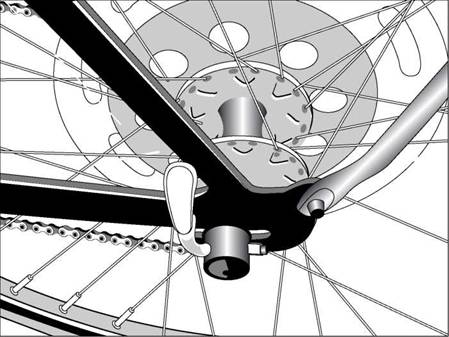The Quickest Release in the West
On a cold day in the middle of a race in the Italian Alps in 1927, engineer and racer Tullio Campagnolo’s hands were so cold that he had trouble removing the wing nuts that held his wheel in place. This experience is supposedly what led him to invent the quick-release lever, something that has made lives easier for scores of bikers ever since.
Anyone who has ever had to remove a wheel on a bike without the benefit of a quick release knows just how much of a convenience Campagnolo’s contribution has been. Whether you’re taking off a wheel to quickly change a flat or to throw your bike into the car, the quick-release mechanism is virtually indispensable to biking.
The basic design of the modern quick release (shown in Figure 2-7) still resembles the original. It’s made of a long rod with a lever-based cam mechanism on one end and a serrated edged nut on the other. When the nut begins to tighten and the lever is lifted, the cam clamps down on the wheel hub.
Make sure to clamp the lever as snugly as you can. Do not rotate the lever like a wing nut — that’s what the quick release replaced, and you won’t be able to get it tight enough to secure the wheel.
|
|
|
Figure 2-7: A quick release on a wheel makes a biker’s life much, much easier. |
Working with quick releases takes a little practice, especially when you’re learning how to tighten the nut just enough so that there’s the right amount of play in the lever to enable it to tighten in the closed upright position.
|
ilNG/ |
|
|
Properly tightening quick-release hubs is important, because if they aren’t tight, they could come loose and the wheel could fall off. Today, most bicycles have front forks that utilize a secondary wheel-retention device to keep the wheel from disengaging if the quick release is incorrectly adjusted. Secondary retention devices fall into two basic categories:
✓ The clip-on type is a part that the manufacturer adds to the front wheel hub or front fork.
✓ The integral type is molded, cast, or machined into the outer faces of the front fork dropouts.
|
|
Ask the people at your local bike shop to explain the secondary retention device on your bike.
Secondary retention devices are not a substitute for correct quick-release adjustment.



